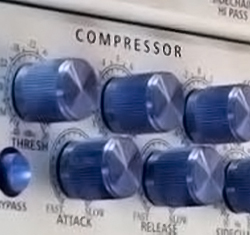
In professionally recorded productions, every track that is susceptible to rapid and dramatic dynamic changes is compressed. Vocals, instruments—virtually everything that contributes to the recording—exhibits dynamic changes in SPL, and over the years we have discovered that we humans don’t like momentary and large dynamic changes. It startles and affronts the listener.
Remember when your best friend crept up behind you as a child and slammed a large book shut right behind your head? They had to peel you off the ceiling, right? Therefore, every piece of music you hear on the radio, on and CDs downloads, on the television and at professional concerts, has been compressed everywhere as necessary to limit these uncomfortable dynamic changes and to smooth out the performance.
Now, back to our perfectly performing band. (Remember them?).The reason they don’t sound as professional may well be due to the lack of compression. When a singer or an instrument hits a note or phrase aggressively, the SPL changes (upwards and quickly … remember, we don’t like that) and the listening audience is subconsciously aware that it doesn’t sound as good as the music we listen to at home.
Another very real circumstance that we experience in audio for worship is a pastor who likes to accentuate occasionally to get his or her point across. You (the engineer) have got this pastor’s channel set so when the message is being delivered in a whisper it’s still being heard.
And then, tragedy occurs. The pastor rips out the point of the message in an extremely exuberant fashion and the words that used to be soft and soothing are now really loud—and the congregation is thinking about how startled they are and totally lose track of the message. They’re also wondering how the mix engineer could allow this to happen.
You (the mix engineer), in the meantime, have noticed that your record levels shot from +3 to +15, and you have red lights all over the place. On the recording, when you get to that spot, instead of comforting speech, you’ll have nice hairy distortion. You ran out of headroom at the recorder inputs due to the transient peak.
A compressor can help solve these nightmares. It will also protect your system. If someone drops a live microphone while the system is operating at a high level, the sudden impact of the mic on the floor can cause an increase in short-term SPL dramatic enough to blow a loudspeaker. Many compressors have “brick wall” limiting, which means you can set it so the transient change in SPL simply will not exceed a set point.
A compressor is a means of bringing a more professional audio presentation to your mix, whether it be weekend band, school musical, worship services, or recording activities. The mix will be more pleasant and easier for you (the engineer) to manage.
Many newer digital consoles are outfitted with compression. Or, if you’re adding a compressor, you can use one side of a dual-channel model for your main mix and the other side for your recorded mix. If funds are available, you can get another unit to compress your monitor mix. Remember, musicians that like what they are hearing are happy musicians. Happy musicians generally play better.
You can also insert one side of the compressor specifically into that pesky singers channel, which allows for extreme vocal delivery changes and dramatic execution of the material without all those nasty technical results.
Jon Baumgartner is a veteran system designer for Sound Solutions in eastern Iowa, a pro audio engineering/contracting division of West Music Company.
